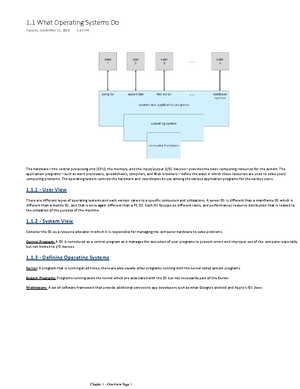- Information
- AI Chat
Was this document helpful?
CS 340 Homework - This is the first Assignment for professor fluture, Basically explaining Operating
Course: Operating Systems Principles (CSCI 340)
16 Documents
Students shared 16 documents in this course
University: Queens College CUNY
Was this document helpful?

Homework 1
Class: CSCI 340
Lecturer: Dr. Simina Fluture
PART A:
Two of the most popular operating systems are MS Windows and UNIX. If you want in
your outline you can choose the Mac OS instead of Unix.
In about two pages (in total), give an outline of each of them. Emphasize on the main
characteristics and the features and advances of the most important versions.
Answer: In this part I will answer about MS Windows and Mac OS.
MS Windows:
- Microsoft Windows is one of the most popular and widely used Operating system
in the world.
- It is developed by Microsoft corporation.
- Microsoft windows was first released in November 1985 as a graphical operating
system shell for MS DOS in order to grow the graphical user interface (GUI).
-First version of Microsoft windows is Windows 1.0, which was released on 1985.
However, it was not a complete operating system. It only extended existing MS
DOS with more features. Some of the components of this operating system are
calculator,
PART B: (about one page) Give the characteristics of the Android’s operating system.
With Android operating system (OS) KitKat version 4.4 rolling out to mobile devices
across the globe, Google is on to something—Android is now more popular than iOS or the
Windows phone. The OS tends to garner rave reviews for its ease of use and open source, but
many iOS or Windows phone users argue that their preferred operating system can do just as
much. In some respects, that’s true, but here are 10 features unique to Android’s OS.
1) Near Field Communication (NFC)
Most Android devices support NFC, which allows electronic devices to easily interact across
short distances. The main aim here is to create a payment option that is simpler than carrying
credit cards or cash, and while the market hasn’t exploded as many experts had predicted,
there may be an alternative in the works, in the form of Bluetooth Low Energy (BLE).
2) Alternate Keyboards
Android supports multiple keyboards and makes them easy to install; the SwiftKey, Skype,
and 8pen apps all offer ways to quickly change up your keyboard style. Other mobile
operating systems either don’t permit extra keyboards at all, or the process to install and use
them are tedious and time-consuming.










